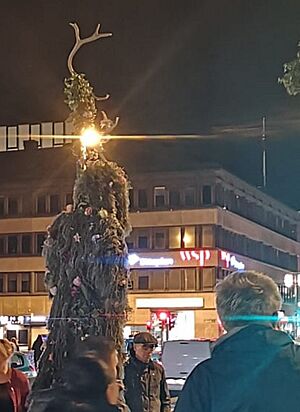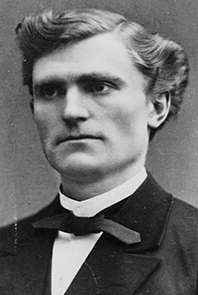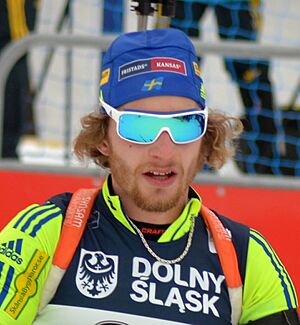Gävle facts for kids
Quick facts for kids
Gävle
|
|
|---|---|

Town square, Alderholmen, old town, the high-rise "Fullriggaren" at Gävle Strand, the town hall, buildings alongside the river of Gavleån
|
|
| Nickname(s):
Gevalia
|
|
| Country | |
| Province | Gästrikland |
| County | Gävleborg County |
| Municipality | Gävle Municipality |
| Area | |
| • City | 42.45 km2 (16.39 sq mi) |
| • Metro | 1,615.07 km2 (623.58 sq mi) |
| Elevation | 8 m (26 ft) |
| Population
(2016)
|
|
| • City | 75,451 |
| • Density | 1,673/km2 (4,330/sq mi) |
| • Urban | 96,969 |
| Time zone | UTC+1 (CET) |
| • Summer (DST) | UTC+2 (CEST) |
| Postal code |
80x xx
|
| Area code(s) | (+46) 26 |
Gävle is a city in Sweden. It is the main city of Gävle Municipality and the capital of Gävleborg County. In 2020, about 77,586 people lived there. This makes Gävle the 13th largest city in Sweden.
Gävle is the oldest city in northern Sweden, called Norrland. It received its official city rights in 1446 from King Christopher of Bavaria. Even though it's in Norrland, Gävle is closer to Stockholm. It also has a much milder climate than most of Norrland.
The city is famous around the world for its huge Gävle Goat. This goat is made of straw and is put up every December. Sadly, it is often vandalized, usually by being set on fire. The Gävle Goat has become a symbol for the city. It is now used to help promote Gävle to visitors.
Contents
History of Gävle
The name Gävle likely comes from an old Swedish word, gavel. This word meant "river banks" and referred to the Gavleån (Gävle River). The first settlement was called Gävle-ägarna, meaning "Gavel-owners". This name was later shortened to Gävle.
Gävle was first mentioned as a town in 1413. It officially became a city in 1446. For a long time, Gävle had small wooden buildings with turf or shingle roofs. Boat-houses were common along the rivers. The city was built around its three most important buildings: the church, the palace, and the town hall.
In the 1400s, Gävle grew because of trade. Its harbor and river helped with this. But in the 1500s, the city was not allowed to trade with other countries. It could only trade with Stockholm and Åbo (which was part of Sweden then). These rules were lifted in 1531. By 1546, King Gustaf Vasa allowed Gävle to trade freely.
A big fire in 1569 destroyed many old records of Gävle from the Middle Ages.
Gävle has had three major fires in the last 300 years. After a fire in 1776, the city was rebuilt with straight streets. More stone and brick houses were built. The biggest fire happened in 1869. About 8,000 out of 10,000 people lost their homes. Almost the entire northern part of the city burned down. The buildings south of the Gavleån river were saved. A small part of the old town, called Gamla Gefle, is still preserved today.
After the 1869 fire, Gävle was rebuilt with wide streets and green areas. This was done to help stop future fires from spreading. Today, Gävle is known as a green city with wide avenues.
In July 1719, Hugo Hamilton defended Gävle from Russian attacks. Russian forces tried to attack the city from land and sea. Hamilton and his defenders stopped them. The Russians gave up and sailed away on August 2.
In the 1950s, the city center was rebuilt. Around 1970, Gävle became a larger area. It joined with nearby towns like Valbo and Hamrånge. New neighborhoods like Stigslund and Sätra grew around the city.
From the mid-1800s to the early 1900s, many Swedes left the country. There were bad harvests and not enough jobs. Gävle was one of the main cities where people started their journey to places like the United States.
During World War I, Gävle's harbor was important for trade. Some ships from Gävle were sunk by German submarines. In June 1945, 800 Soviet prisoners of war passed through Gävle. They were sent back to the Soviet Union from the harbor.
In 1986, after the Chernobyl disaster, Gävle was affected by radioactive fallout. It was one of the most affected areas outside the Soviet Union.
In 2022, the old City Library Building was taken down. A new cultural center, Agnes Kulturhus, is being built there. In 2023, King Carl XVI Gustaf visited the construction site. He left a plaque and a time capsule there.
Geography and Climate
Gävle is located by the Baltic Sea. It is near where the Dalälven river flows into the sea. Gävle is at 60 degrees north and 17 degrees east. This means it has the same latitude as Helsinki. It has the same longitude as Vienna and Cape Town.
Gävle has a climate similar to central Sweden. Winters are just below freezing, and summers are a bit above 20°C (68°F). The city gets about 600 mm (24 inches) of rain each year. Gävle has a humid continental climate. This is special because most places north of 60 degrees latitude have colder climates.
In August 2021, Gävle had a very heavy rainstorm. It rained 16 cm (6 inches) in one day. This caused major flooding in many areas. Neighborhoods were underwater, and vehicles were submerged.
| Climate data for Gävle (2002–2021 averages; extremes since 1901) | |||||||||||||
|---|---|---|---|---|---|---|---|---|---|---|---|---|---|
| Month | Jan | Feb | Mar | Apr | May | Jun | Jul | Aug | Sep | Oct | Nov | Dec | Year |
| Record high °C (°F) | 11.0 (51.8) |
12.5 (54.5) |
18.3 (64.9) |
27.1 (80.8) |
28.9 (84.0) |
36.4 (97.5) |
34.4 (93.9) |
34.0 (93.2) |
28.0 (82.4) |
22.7 (72.9) |
15.0 (59.0) |
11.7 (53.1) |
36.4 (97.5) |
| Mean maximum °C (°F) | 6.2 (43.2) |
8.0 (46.4) |
13.6 (56.5) |
18.3 (64.9) |
24.0 (75.2) |
27.1 (80.8) |
28.8 (83.8) |
27.4 (81.3) |
22.9 (73.2) |
16.3 (61.3) |
11.2 (52.2) |
7.4 (45.3) |
29.8 (85.6) |
| Mean daily maximum °C (°F) | −0.4 (31.3) |
0.7 (33.3) |
4.7 (40.5) |
10.0 (50.0) |
15.1 (59.2) |
19.5 (67.1) |
22.2 (72.0) |
21.2 (70.2) |
16.6 (61.9) |
9.7 (49.5) |
4.5 (40.1) |
1.3 (34.3) |
10.4 (50.8) |
| Daily mean °C (°F) | −3.8 (25.2) |
−2.9 (26.8) |
0.2 (32.4) |
4.9 (40.8) |
9.7 (49.5) |
14.2 (57.6) |
16.7 (62.1) |
15.8 (60.4) |
11.7 (53.1) |
6.0 (42.8) |
1.9 (35.4) |
−1.5 (29.3) |
6.1 (42.9) |
| Mean daily minimum °C (°F) | −7.1 (19.2) |
−6.5 (20.3) |
−4.3 (24.3) |
−0.2 (31.6) |
4.2 (39.6) |
8.7 (47.7) |
11.2 (52.2) |
10.4 (50.7) |
6.8 (44.2) |
2.2 (36.0) |
−0.7 (30.7) |
−4.3 (24.3) |
1.7 (35.1) |
| Mean minimum °C (°F) | −20.1 (−4.2) |
−18.9 (−2.0) |
−14.7 (5.5) |
−6.3 (20.7) |
−2.6 (27.3) |
2.5 (36.5) |
5.0 (41.0) |
3.1 (37.6) |
−0.9 (30.4) |
−5.5 (22.1) |
−10.0 (14.0) |
−15.0 (5.0) |
−23.7 (−10.7) |
| Record low °C (°F) | −30.4 (−22.7) |
−33.7 (−28.7) |
−29.9 (−21.8) |
−17.9 (−0.2) |
−7.3 (18.9) |
−4.5 (23.9) |
1.0 (33.8) |
−2.2 (28.0) |
−5.7 (21.7) |
−15.1 (4.8) |
−22.5 (−8.5) |
−30.3 (−22.5) |
−33.7 (−28.7) |
| Average precipitation mm (inches) | 36.5 (1.44) |
26.8 (1.06) |
26.1 (1.03) |
23.1 (0.91) |
43.7 (1.72) |
67.2 (2.65) |
61.5 (2.42) |
92.7 (3.65) |
45.4 (1.79) |
67.2 (2.65) |
46.0 (1.81) |
40.7 (1.60) |
576.9 (22.73) |
| Average extreme snow depth cm (inches) | 31 (12) |
39 (15) |
31 (12) |
13 (5.1) |
0 (0) |
0 (0) |
0 (0) |
0 (0) |
0 (0) |
2 (0.8) |
10 (3.9) |
20 (7.9) |
47 (19) |
| Source 1: SMHI Open Data | |||||||||||||
| Source 2: SMHI climate data 2002–2018 | |||||||||||||
Gävle's Economy and Trade
Trade at Gävle's port grew a lot in the 1400s. Copper and iron were sent out from here. For a while, Gävle was not allowed to sail to foreign ports. This was to make sure all trade went through Stockholm.
In the 1500s, Gävle was a very important port city. It had many shipping companies and places to build ships. In 1787, Gävle was given "free and unrestricted sailing rights." This meant it could trade with any foreign port. This led to more trade, new buildings, and industrial growth.
From 1910 to 1979, Gefle Porslinfabrik made porcelain products. This factory was called 'Pottan' by locals. Today, there are not many shipping companies or shipyards left. But Gävle still has an important port. Over 1000 ships visit it each year. It is one of the top ten busiest ports in Sweden.
Major Companies in Gävle
Some big companies in Gävle today include:
- BillerudKorsnäs (makes pulp and paper)
- Jacobs Douwe Egberts S.E. AB (makes Gevalia coffee)
- Cale Industri (makes parking meters)
- Cibes Lifts (makes lifts for buildings)
Culture and Fun in Gävle
Gävle has a lively cultural scene for its size. Many musicians, like The Deer Tracks, come from here. The city even tried to become the European Capital of Culture in 2014.
Museums and Arts
Gävle has three main museums:
- The Prison Museum of Sweden: This museum is near Gävle Castle. It shows the history of crime and punishment in Sweden.
- The County Museum of Gävleborg: Located downtown, it has art from the 1600s to today. It also has a section on cultural history.
- The Swedish Railway Museum: This museum has a collection of trains and railway history. It started in Stockholm in 1906 and moved to Gävle in 1970.
Gävle also has a theater that dates back to the 1800s. It still hosts plays, opera, and comedy shows. A concert hall opened in Gävle in 1998. It is home to the Gävle Symphony Orchestra, which started in 1912.
Local Media
Gefle Dagblad and Arbetarbladet are the two main newspapers in Gävle. Both have been around since the late 1800s or early 1900s. The national TV broadcaster, SVT, has an office in Gävle. The national radio station, Sveriges Radio, also broadcasts from the city.
Sports in Gävle
Gävle has strong sports teams. They play in the top national leagues for:
- Football (Gefle IF)
- Ice hockey (Brynäs IF)
- Floorball (Gävle GIK)
|
Speed skating
|
|
|

Å-Draget Festival
Every September, Gävle Municipality holds a special weekend called Å-Draget. Outdoor candles are lit along the Gavle River. This highlights the river's beauty and its importance to the city. The municipality also organizes performances and activities for everyone to enjoy along the river.
Education in Gävle
The University College of Gävle has about 16,000 students. It offers over 800 courses and about 50 degree programs. These programs cover technology, science, and humanities. The university focuses on research in "Built Environment" and "Health in working life." Some courses are taught in English for both international and Swedish students.
Fun Facts About Gävle
Gävle is known as the birthplace of the Gevalia coffee brand. This coffee is made by Kraft General Foods Scandinavia and sold worldwide. Gevalia is very popular in the Americas. It makes many unique flavored coffees for the United States that are not sold in Europe. However, you can try many special blends if you visit the factory in Gävle. (Gevalia is the old Latin name for Gävle).
Other famous brands from Gävle include Läkerol throat lozenges. Also, the car-shaped sweets called Ahlgrens Bilar come from here.
Gävle also remembers Joel Emmanuel Hägglund, known as Joe Hill. He was a labor activist and songwriter born in Gävle in 1879. His family home still stands in the Old Town at Nedre Bergsgatan 28. Today, it is a museum and a cultural center called Joe Hill-gården.
The Gävle Goat Tradition
The story of the Gävle goat began in 1966. Stig Gavlén had the idea to put a giant straw Christmas goat in Slottstorget (Castle Square). On December 1st, the huge goat was put up. It was 13 meters (43 feet) tall, 7 meters (23 feet) long, and weighed 3 tons.
At midnight on New Year's Eve, the goat burned down. Since then, the goat has often been burned almost every year. By 2005, it had been burned 22 times. Burning the goat is against the law and most people in Gävle do not like it. But this is what has made the goat so famous. In 2006, the goat was covered in a special flame-resistant coating. This helped it stay standing that winter. By December 27, 2015, the goat had been burned 28 times. In its 54-year history, the goat has been burned down 38 times.
Famous People from Gävle
- Linn Ahlborg (born 1999) – blogger and influencer
- Alexandra Dahlström (born 1984) – actress and film director
- Thomas Di Leva (born 1963) – singer and songwriter
- Hans Forssell (1843–1901) – historian and writer
- Åke Fridell (1919–1985) – film actor
- Valborg Elisabeth Groning (1890-1970) – circus performer, known as La Bella Ingeborg
- Joe Hill (1879–1915) – labor activist and songwriter
- Rolf Lassgård (born 1955) – actor in crime dramas
- Regina Lund (born 1967) – actress and singer
- Cat Stevens (born 1948) – musician; his mother was from Gävle
- Lars-Åke Wilhelmsson (born 1958) – fashion designer and drag artist
Sports Stars from Gävle
- Nicklas Bäckström (born 1987) – ice hockey player for the Washington Capitals
- Christian Djoos (born 1994) – ice hockey player, won Stanley Cup in 2018
- Anders Eklund (1957–2010) – Olympic heavyweight boxer
- Peppe Femling (born 1992) – biathlete and Olympic gold medalist
- Andreas Johnsson (born 1994) – ice hockey player for the San Jose Sharks
- Calle Järnkrok (born 1991) – ice hockey player for the Toronto Maple Leafs
- Ewa Laurance (born 1964) – professional pool player
- Oskar Lindblom (born 1996) – ice hockey player for the San Jose Sharks
- Anders Lindbäck (born 1988) – ice hockey goalie for several NHL teams
- Elias Lindholm (born 1994) – ice hockey player for the Vancouver Canucks
- Jacob Markström (born 1990) – ice hockey player for the New Jersey Devils
- Felix Sandström (born 1997) – ice hockey goalie for the Philadelphia Flyers
- Jakob Silfverberg (born 1990) – ice hockey player for the Anaheim Ducks
Sister Cities
Gävle is connected with five sister cities:
 Jūrmala, Latvia
Jūrmala, Latvia Galva, Illinois, United States
Galva, Illinois, United States Næstved, Denmark
Næstved, Denmark Rauma, Finland
Rauma, Finland Gjøvik, Norway
Gjøvik, Norway
Images for kids
See also
 In Spanish: Gävle para niños
In Spanish: Gävle para niños
















